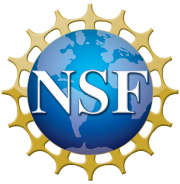Vis-a-thon 2025
In Depth: Learning from the Ocean Floor
Authors
Coralie Rodriguez Ph.D. Candidate, University of Rhode Island, Graduate School of Oceanography
COLLABORATOR
Maite Sosa Methol MFA, Rhode Island School of Design, Textiles issuu.com/temaite/docs/porfolio_vis_a_thon_2025
Critic
Leah Beeferman
This project emerges from the aim to creatively visualize research on ferromanganese crusts, deep-sea rocks made from ambient seawater that serve as records of ocean history.
This knitted textile piece offers a tangible way to bring the deep sea up, making visible some of the unseen processes happening in the depths of the ocean. Ferromanganese crusts have recently drawn attention due to their high concentrations of economically valuable metals. As discussions and projects on deep-sea mining increase, so do concerns about its environmental impact, including habitat destruction, pollution, and sediment disturbances. These rocks, which take millions of years to form, hold invaluable information, making their preservation for scientific study crucial.
Knitting serves as a way to materialize the interconnectedness of the ocean. Just as a single yarn loops and entangles to form a fabric, the ocean can be thought as one vast, continuous system, a conveyor belt. This project highlights the importance of ferromanganese crusts as storied materials that hold memories of the ocean, advocating for their conservation and deeper understanding before they are irrevocably altered.
INITIAL PROPOSAL NOTECARDS
"When I originally applied to be a part of VIS-A-THON, I knew that I wanted to create a piece that would bring awareness to my topic of study: ferromanganese crusts, deep-sea rocks made out of seawater. My original idea was to tell a story about the rocks and their connection with the ocean, a way to bring the deep-sea up to land—submarine to subaerial. These rocks hold abundant economically valuable minerals locked within their matrix, which can be used in goods such as rechargeable batteries, electric vehicles, etc. While stakeholders are interested in potentially mining this deep-sea resource, these rocks are also recorders of ocean chemistry over the timing of their formation."
—Coralie
"One of the most important aspects of the process was having a solid plan. Conducting experiments and testing materials before the Vis-a-thon weekend was crucial to ensuring a smooth workflow. I was surprised by how naturally the project developed. We started working right away, and everything progressed smoothly. Coralie also had experience working with textiles, which was great—it made the collaboration even more fluid. I think she is now an experienced knitter as well!"
—Maite
"I was drawn to the idea of creating a textile piece using certain knots/links to show organization versus disorganization, and corresponding to man-made versus raw materials. Maite helped to explain different knitting styles that we could use to help show this in the final piece. I am also very grateful to Maite for showing me the possibility of growing alum crystals on textiles."
—Coralie
FINAL IMAGES
Tools Used in the Project
Undyed single-ply raw wool Single-bed knitting machine Alum Crystals
Copyright
© In Depth: Learning from the Ocean Floor, 2025

This material is based upon work supported in part by the National Science Foundation under EPSCoR Cooperative Agreement #OIA-1655221.
Any opinions, findings, and conclusions or recommendations expressed in this material are those of the author(s) and do not necessarily reflect the views of the National Science Foundation.





